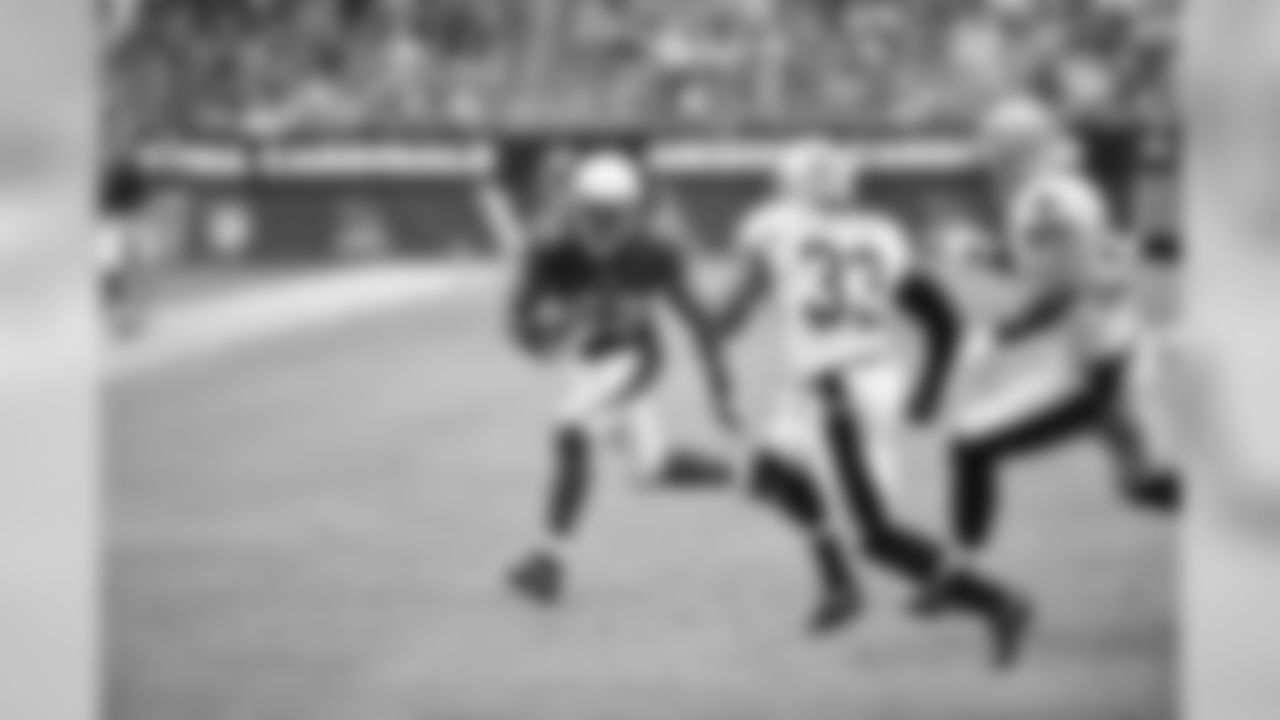Before Chris Johnson decided to sign with the Cardinals back in August, Stump Mitchell had to make one thing clear.
"I love Andre Ellington," the Cardinals' running backs coach told Johnson. "I love Kerwynn Williams. I love Stepfan Taylor. I love all the running backs we have here right now. Honestly, we don't need you to win."
Honesty was all Johnson was seeking.
His one year with the Jets in 2014 left the veteran back yearning to be treated fairly. The gunshot wound to his shoulder left him wondering if he was still going to be able to play in the NFL. His age compounded his difficulty finding a team with which to sign.
Johnson was on the Cardinals' radar during the summer, but it wasn't until training camp when the team made a final push to add him to Andre Ellington and rookie David Johnson in their backfield. The idea was that he could supplement the running game – not that he would eventually carry it.
Johnson wanted the right situation, and finally decided – even with no promises of playing time and with an incentive-laden minimum-salary contract – Arizona was that place. When Ellington got hurt in the season opener, Johnson stepped in to perform better than anyone could've expected.
With bullet fragments still in his shoulder, Johnson already has 676 yards rushing halfway through the season (third in the NFL) and has averaged 4.8 yards a carry. He has four 100-yard rushing games, the first Cardinal to do that in a season since, coincidentally, Mitchell did it in 1985. He's already earned some of his incentive money when he reached 664 yards – or one more than he had in that frustrating season in New York.
He's played so well that Ellington, who returned a month ago from the knee injury that undercut his season opener, hasn't been able to regain the starting job. He's played so well that the Cardinals have 998 yards rushing, the most the team has had at the season's midway point since 1988. Johnson's personal pace would give him more rushing yards than any Cardinals' back since 1981.
"I knew I was going to have a role," Johnson said. "I just wasn't sure how big it would be or how small it would be."
The Jets had released Johnson in March. He was already gearing up to get ready for an offseason – he decided to work out with Fox reporter/mixed martial arts trainer Jay Glazer for the first time – when he was with friends in his hometown of Orlando, Fla. In a drive-by shooting, Johnson took the bullet that cost a friend his life and nearly cost Johnson his career.
Images of Cardinals running back Chris Johnson

























"Lots of nights crying myself to sleep," Johnson said.
He was on bedrest for six weeks. He was in pain. He couldn't use his right hand. He had broken three bones in his shoulder. He had broken a rib. His quest for 10,000 career yards (he was at 8,626 before the season began) took a backseat to a scary reality.
"That's when I wondered about what direction my life would take," he said.
Eventually, he found his way back to Glazer. Glazer trains dozens of NFL players at his Unbreakable gym in Los Angeles – Cardinals defensive tackle Calais Campbell worked out there this offseason – but Johnson was in a much different place than most NFL players.
"Bullets tend to get in the way of success," Glazer told TMZ Sports.
Glazer said when Johnson first returned to his gym, Johnson's arm was still in a sling and lower-body work was all Johnson could do. Johnson acknowledged he had to heal both physically and mentally. His intent to go to Glazer in the first place was just to try something new.
But by the time he returned, with the other NFL guys going back to their teams for offseason OTAs and minicamps, Johnson ended up with some punishing one-on-one work every day.
"I think that helped me out," Johnson said.
"A lot of guys are not willing to go the extra step," Glazer said. "We put Chris through a dark time.
"Eighty percent of the players out there, especially pro athletes, they don't want to deal with that. … Chris, to his credit and this late in his career, he took it. And most guys won't do that."
He once gained 2,006 yards in a season, but for most of the offseason, Johnson wasn't healthy enough to earn a looksee from teams. After that, the mere fact he had been shot didn't help his search.
"I'm pretty sure it scared a lot of teams off," Johnson said.
There were places that made sense to him as potential fits, but they weren't calling. Johnson admitted he had to find patience, especially as training camps drew near. He couldn't just dial up a team and invite himself in.
"It don't work like that," Johnson said. "I thought it used to work like that but it doesn't. At the end of the day, you've got teams that have their rosters set. They
have players who have been through OTAs and offseason workouts. It's out of your hands."
Ellington and David Johnson suffered hamstring injuries early in training camp, and the discussions between the Cardinals and Johnson increased in importance. The Cardinals wanted extra depth, Johnson wanted an offense in which he could be successful.
Johnson just made it clear, after what happened with the Jets, he wanted to be treated fairly.
"You have a résumé, you have something none of these guys have," Mitchell told Johnson. "You've gained 2,000 yards, you've gained 1,500 yards and what you have to believe is that we will treat you just how you said you wanted to be treated – fairly. If that means you beat somebody out, you do it. If you don't, there's going to be a role for you. But I don't want you coming in here thinking, I'm lying to you."
Mitchell emphasized that regardless of Johnson's role, Bruce Arians was going to put Johnson in a position to make plays. The one thing Johnson said he learned in New York was to be appreciative of the opportunities he did get, and he was willing to work with the situation.
When the season started, Johnson said he just wanted to get into football shape – for as hard as Glazer pushed him, it wasn't the same as when he was on the field, and lost camp time to his own hamstring problem didn't help – and learn the playbook.
The Cards liked that his skillset and abilities were similar to Ellington, so that if Ellington did get hurt, the offense didn't have to change. When Ellington was sidelined, Johnson seamlessly stepped in.
"It's no different than when (linebacker) John Abraham came here and everyone thought he was going to be a third-down rusher only and he morphed into a full-time starter," General Manager Steve Keim said. "I think he appreciated the fact we were honest with him."
Keim has been impressed with how physical Johnson has run the ball. Despite his offseason injury, Johnson has been remarkably durable as a running back, having missed just one game in his eight-year career.
Mitchell said Johnson has been a "pleasure" to have at the position, and that included his brief time on the bench early in the season. Mitchell also sees a chance for Johnson to win the NFL rushing title, something the coach would like to accomplish knowing it'll help the Cardinals' drive to win a division.
Arians did say after Johnson's 30-carry game in Cleveland it was probably more attempts than he'd like Johnson to have in a game. The hope is that Ellington will be more of a factor in the second half of the season.
But Johnson is going to remain the starter. That he has earned, even as it was never promised.
"I felt like it was in me," Johnson said. "I just had to go to the right situation and get the right opportunities."















